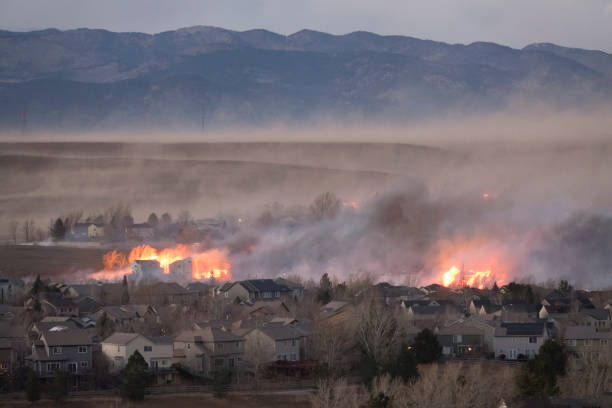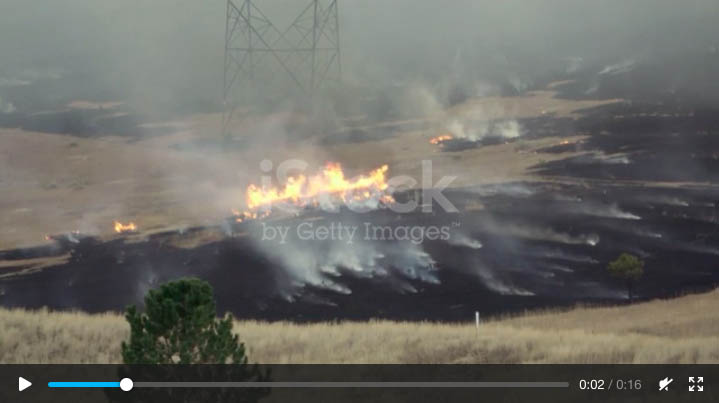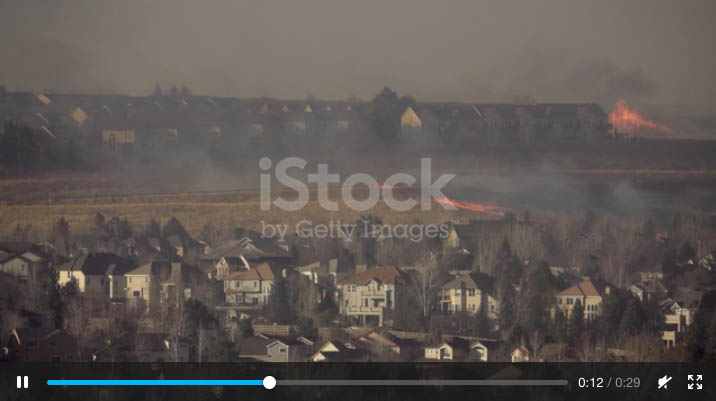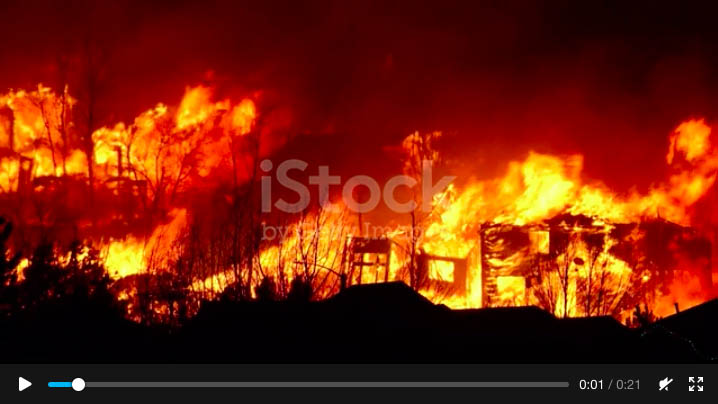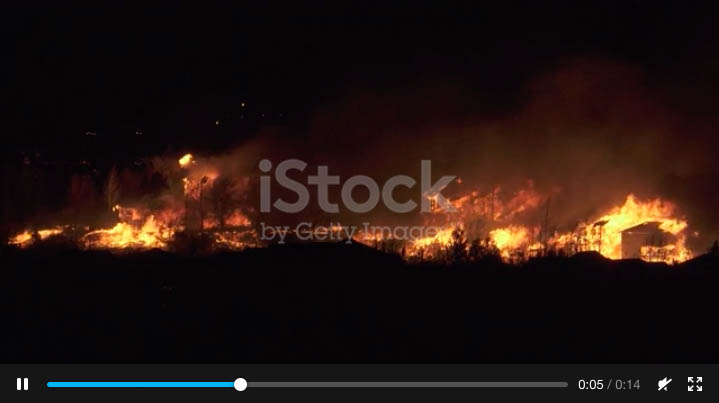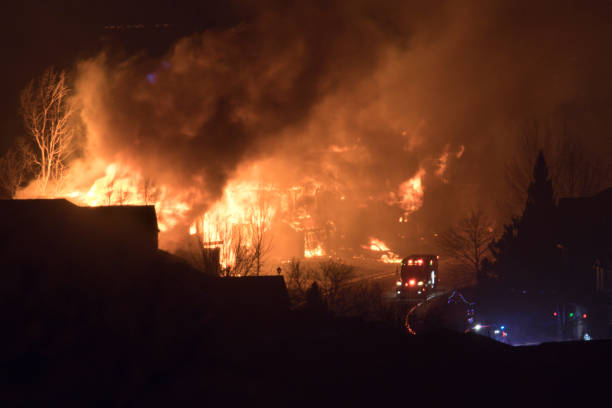 |
 |
 |
   |
Superior Suburban Fire - Marshall Fire Disaster January 14, 2022 Photos and text by Dave Parsons Pine tree branches thrashed back and forth violently as leafless poplar trees bent dangerously low over the neighbors parked RV. More damn wind. Heavy gusts shook the house as the rafters made popping sounds which echoed through the attic. The past few years, heavy wind events have been occurring more regularly with definitely more violence, pushing over dozens of fences, ripping off siding, roofing shingles and of course blowing over neighborhood trash and recycle cans, spewing plastic into the unreachable tops of every tree close by. Semi trucks are easily blown over, like oversized toys. The extreme pressure changes reverberate through my sinuses with sharp stabbing pains behind my eyes. Another fire has started along the foothills, this time to the north, by Boulder, Colorado. Unfortunately, the current bone dry conditions in Colorado are unprecedented and are perfect for wild fires. Denver smashed it’s previous 87 year old record of latest snow date by nearly three weeks, receiving only .3 inches of snow on December 10 and nothing since. Just a couple of weeks ago, returning from my run, I watched billows of smoke blow eastward from the foothills of the Rocky Mountains in Littleton. I watched a wall of flames mow through fields of dry, brown, grass as I set up my tripod to video more drought fueled destruction. I photographed the high winds push the fire up a steep hillside into the scrub oak along C-470 by Ken Caryl. Fire fighters drove their vehicles over the charred and blackend soil and quickly put out the burning line of fire. Flying low, a small fire fighting plane flew a test run over the remaining flames and circled back. Coming in low and fast again with the winds still howling, the pilot paralleled the hogback and skillfully dropped a line of water over unburnt areas and well into the hotspots, successfully dowsing much of the fire. Near sunset, the winds began to calm as a blinking drone zipped through my viewfinder towards the hot area I was photographing. Fire crews, now hiking in the dark, used their flashlights to maneuver through the steep and rough terrain to extinguish their drone guided targets.
Sure, there is adrenaline and morbid curiosity, like watching a slow motion auto accident in front of you, but after years of inhaling toxic smoke and avoiding idiot fire fans, my self inflicted freelance directive to document climate change events was wearing thin. Now the television was showing thick smoke and wind buffeted reporters. The wind was still rattling the house. I told myself this is going to be bad as my wife suggested to me ‘you don’t have to go.’ I told her, I will take my time and wander north as I probably wouldn’t be able to get anywhere close. I loaded up the tripods and camera gear in my old truck, knowing the winds were going to wreak havoc on my windshield. Turning off the on ramp, the highway was closed due to high winds as parked trucks and orange cones blocked northbound lanes of C-470. Traffic was re-routed onto eastbound 285 and masses of drivers lined up at Wadsworth, trying to correct their travel direction. I passed the huge vehicle lines on the left and exited on Kipling, the next northbound route. Driving the back roads, I tootled northwards watching the massive plume of smoke, once again streaming eastwards. I passed 6th Avenue, then Colfax, and past Crown Hill Lake and I-70, then past Standley Lake and Rocky Flats National Wildlife Refuge. Making good time, I’m was soon overlooking the Interlocken golf course, right next to the Rocky Mountain Metro Airport. Surprised how close I was able to get to the smoke, I pulled into a parking lot area to avoid Eldorado Boulevard where lines of vehicles with watchers were pulled off to the road side and blocking the lanes. Staying south of the giant smoke plume kept me out of the heaviest of the toxic burning house smoke and emergency traffic. More than half mile away from any flames, I pulled over in a parking lot area and set up the tripods, one for video and the other for photos with an old 12 pound 600mm lens. I struggled to open the truck door against the swirling winds which threw ash and dust in my face. I spit out the newly acquired grit in my teeth. Just overhead, a Lear jet took off into the wind, westwards, right over the fires. Winds howling, I searched for a secure spot near the truck to shoot photos. Re-parking the truck as a wind block, I set up next to the driver’s door. Vehicles were pulling out of the office building parking lot as an employee drove close. I asked him if it was ok to stay where I was. He said yes, I was good, and he was concerned that the fire looked like it may crest the ridge to the northwest. As we talked, I continued to set up. The fire came over the ridge in a fury, running through open fields in between condos and homes. In the wind noise I had to tell him twice the fire has crested the ridge. Still seated in his truck, he craned his head around and looked towards the ridge, said something like ‘stay safe’ and drove off. I put on another coat, double folded my Buff and pulled it tightly over my head as I shot video and photos. Looking through the long lens, the flames roared through the dry grass disturbingly fast, rising to the height of two story homes and then subsiding low and mean as heavy gusts pushed it down. The wind whipped flames and thick smoke made it difficult to keep the rapidly advancing grass fire in the camera frame.
As I opened my eyes everything was bright and blurry! My prescription sunglasses had been ripped off my face and my Buff torn from my head! Squinting my eyes, I yanked open the driver side door, tossed in the heavy camera, letting the wind slam the door shut. More grit settled down the back of my neck and in my mouth. Later, I would find tree bark mulch in my waist band. Reaching back into the truck, I grabbed my back-up glasses and ski goggles. The small camera was surprisingly still working, so I set things back up and continued shooting video and left the rescued big lens in the truck. While video was recording, I looked around the truck for my sunglasses and Buff. I approached the other vehicle and asked if they saw where anything went. The older couple said yes - they saw my hat fly off! No where to be found, my spectacles probably ended up in Kansas. The most violent winds I’ve ever been in, I learned later that day 110 mile an hour gusts were clocked blowing through the area. So that’s what it is like to stand in a mild tornado! With smoke obscuring any view, I quickly disassembled the gear and took shelter in the truck. Rocking back and forth in wind gusts, the cab was quiet and warm as I looked out my newly sand blasted windshield. The poor old truck was taking a beating today. Deciding to change locations, I drove back up to a higher vantage point on 120th Avenue. Police had not yet closed any of the roads. Traffic was busy, as it always was around fire events which draws in plenty of crazy. It was like a disaster sporting event with people driving slowly, looking out their windows blocking traffic, while others were recklessly speeding and some pulled off the side the road. Finding a large gap in between the long line of parked vehicles, I quickly pulled far off the road into the dirt. For a while, enjoying the warm inside the truck, I watched people get out of their cars, fight the wind while walking across a open field with their hair blowing wildly. They lined up at the overlook holding their cell phones towards the smoke plume in the sky. Manly man diesel trucks gunned their motors spewing black smoke and drivers honked in anger as they swerved around those too slow.
Emergency vehicles with the sirens blaring and lights flashing navigated past everybody. Eventually, I too, walked across the field, and joined the audience. Avoiding cactus and yucca spines, I set up a safe Covid distance from other viewers and news teams above the St. Francis Trail on the windblown hill. Recording the destruction while sitting in the dirt, the camera set up low to the ground, the frame still bounced wildly in the wind. While recording video, I listened to the odd atmosphere on the overlook as some people laughed and talked loudly as they watched the burning while others stood quietly as the massive winds blew dust, dirt, ash and smoke into a huge brown mass blowing eastwards. I wondered if any of the unfortunate fire evacuees were watching. Unknown to me at the time, entire neighborhoods of homes and businesses to the north were burning.
Having enough of the human circus and buffeting winds, I ran the vehicle gauntlet and returned to my previous location, this time staying in the truck and rolling down the window half way for photos. The sun had set behind the Front Range foothills of the Rocky Mountains and the light and temperature were dropping, but not the winds. They still raged, buffeting the vehicle. I looked again for my glasses, a much wider circle this time but still no luck. Walking through the tempest, dry grass, dead leaves, ash and debris floated across the hateful sky. Indifferent to the surrounding disaster, a northern harrier hawk hovered unmoving, twenty feet in front of me. The raptor, seemingly enjoyed the violent winds, harnessing the natural phenomenon effortlessly, gliding gently right and left and then swooping vertically like a jet fighter, disappearing behind the brick office building.
Some flaming grass fields burned out in a cloud of smoke and swirling ash as they reached corners of cement sidewalks. Unfortunately, one greenbelt grass fire wove its way through a maze of homes tossing embers and igniting spot fires in the neighborhood center. Looking across the Interlocken Golf Course at the Rock Creek neighborhood, an entire fence line was rapidly engulfed in glowing flames. Where was the fire department? Blinking light vehicles kept driving by on Indiana Street, but no one stopped at the burning fence. Feeling pissed off no one was reacting, the yard went up next, then the deck and side of the house and then the house next door. I thought about what I could do. Do what - run through a mile of hills, yards, multiple fence lines and unfamiliar terrain in the dark and thick smoke, find an unfrozen hose, hook it up to some hidden outlet on the side of the house and put out a raging fire before being overcome by smoke inhalation? Walking outside again, I was able to lean heavily into the strong winds. Taking a few photos from a different perspective, my whole body vibrated like a flag as I squeezed the camera shutter release. Returning to the truck, my legs were almost whipped out from under me as I leaned back like a heavy sail. Further away where spot fires had started earlier, large orange glows radiated through the thick smoke as home after home went up in vast fireballs of horizontal burning and blowing flames. As the sky grew darker, terrifying fire glows grew in size as entire lines of homes and condos became engulfed. Finally, hours after sunset, the howling wind calmed and I could to hear the eire sound of small explosions detonating randomly from burning homes across the neighborhood. Once again, people were drawn to the overlook. In the dark, like giant moths attracted to the burning flames, their glowing cellphone eyeballs permanently attached to their faces like a sensory input recorded the scene.
It was hard not to be fascinated by the enormity and destruction of the scene. An entire neighborhood was erupting in a rage of flames, a fiery inferno, a hell on earth. Looking through the long lens, a home skeleton of studded walls collapsed in a shower of sparks. On another fully engulfed house, orbs of molten fire dripped off the siding and fell through the glowing remains of a deck. Depending on the wind speed, home skeletons glowed with varying intensity. Flames started to change directions from horizontal to vertical as the winds slowed. Red and blue emergency vehicle lights blinked in the dark through rising heat waves. Christmas lights, still hanging from the recent holiday ironically blinked, bounced and happily glowed around the growing menace of flames. A charred husk of a car sat on its tireless rims and glowed like a crisped jack-o-lantern still parked in a home driveway. My clothes and hair reeked of smoke as I called my wife and later my father, whom I had to relay the tragedy of the scene unfolding in front of me.
Later, I would learn the Marshall fire, located in suburbia between Denver and Boulder, Colorado on December 30, 2021 destroyed over 1000 homes, burning them down to the foundation. Numerous businesses also burned. Power was cut to 34,000 homes and over 30,000 residents were forced to evacuate. Sustained winds up to 80 to 100 miles per hour fueled apocalyptic fires which tore across open grasslands and through homes in Superior and Louisville, Colorado. Aftermath drone footage would fly over numerous war zones of massive burnt out destruction. On local television, interviews with experienced fire fighters with powerful water hoses and thousands of gallons of water were overwhelmed and defeated by the force of the raging fire. This was the most destructive fire in Colorado history. Heavy snow finally fell the next day.
|
Destinations in the Gallery
All contents copyright ©Dave Parsons
DP Home | Feature | Gallery | About
